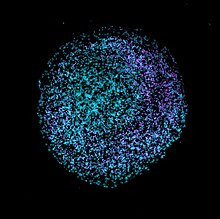Organoid intelligence
As opposed to traditional non-organic silicon-based approaches, OI seeks to use lab-grown cerebral organoids to serve as "biological hardware."
[4] Brain-inspired computing hardware aims to emulate the structure and working principles of the brain and could be used to address current limitations in artificial intelligence technologies.
However, brain-inspired silicon chips are still limited in their ability to fully mimic brain function, as most examples are built on digital electronic principles.
One study performed OI computation (which they termed Brainoware) by sending and receiving information from the brain organoid using a high-density multielectrode array.
[6] Enforced amnesia and limits on duration of operation without memory reset have been proposed as a way to mitigate the potential risk of silent suffering in brain organoids.

